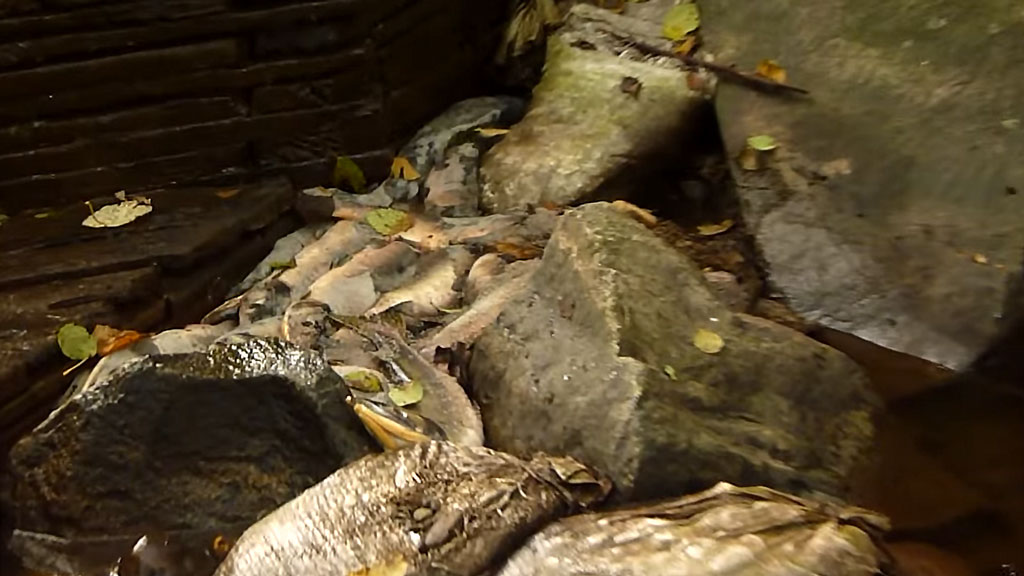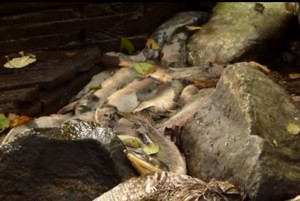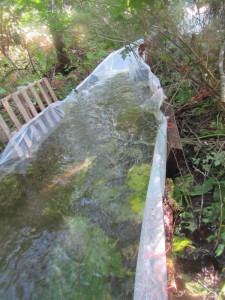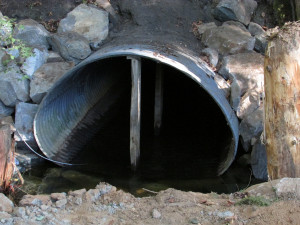Well, it was a busy month but the restoration work got done and boy, what an improvement it made! We took out the old weir at Second Street that was impeding fish movement at best and killing fish at worst as you can see from the before video.
Many, many thanks go out to our wonderful volunteers for rescuing, brace yourself:
1215 Coho,
23 Cutthroat Trout,
9 Rainbow Trout,
76 sculpin,
3 sticklebacks,
215 Lamprey of all 3 species,
114 crayfish,
37 Western Pearlshell mussels, and a myriad of other critters like scuds, caddisfly larvae, dragonfly nymphs, stonefly larvae, etc. All of that was in a one block stretch of the creek between First and Second Streets.
The work in this location was relatively easy as we simply put a dam across the channel we were working in and let the water flow down the other channel. The ‘fishing’ was also relatively easy as all the critters came out of their hiding places when the water disappeared so we could gather them up and put them on the other side of the safety net. We replaced the weir with a series of riffles and pools that the fish seem to be really appreciating as you can see in the video.
We were really worried that we wouldn’t get the culvert work completed before the Pinks made their way up to that location but succeeded in the knick of time.
The ‘repair’ work at the Comox Logging Road site was needed to raise the water level up to the bottom of the culvert so the fish could get through instead of being stuck in the pool below the culvert waiting for enough water to flow during increasingly dry periods. This second project location was much more challenging to ‘fish’ and to get the water out of the work area. We finally succeeded in diverting the flow to the slip and slide after deploying 1 x 6 inch pump, 3 x 4 inch pumps and 1 x 3 inch pump! That was all the pumping capacity in the Valley so it is a good thing it worked. Again our thanks go out to our wonderful volunteers for ‘fishing’ out this area which wasn’t as fish-rich but which produced an amazing number of Western Pearlshell mussels. We moved:
179 Coho,
27 Cutthroat Trout,
22 Rainbow Trout,
10 Sculpin,
0 Stickleback,
87 lamprey of all 3 species,
168 crayfish, and
174 Western Pearlshell mussels!
We also discovered that the Cave Crickets have a definite liking for canned herring as we caught several in the minnow traps that we were using to get the fish out from the shelf underneath the culvert that we couldn’t reach with the nets. We also found several large Pacific Lamprey and Cutthroat Trout in this location whereas we found mostly smaller lamprey and fish at the Second Street site.
Basically what we did here is fill in the pond the water flowing out of the culvert had carved out with a lot of large rocks. We also placed a lot of rock around the culvert to help support it and reduce erosion and added some woody debris around the edges so the fish would have some protection from predators. Once that was done we needed to ‘raise’ the streambed to the new level so that we didn’t simply move the jumping problem downstream. That was done with a lot more rock to create a riffle leading to the pond that the slip and slide emptied into as you can see from the final photo.
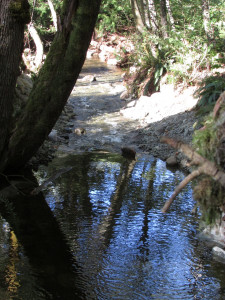 We are extremely grateful to our generous funders: Environment Canada through the Habitat Stewardship Program for Species at Risk, the Fish and Wildlife Compensation Program, and the Habitat Conservation Trust Foundation. In kind and cash donations have also been received from Fortis Gas, Timberwest and Current Environmental. Without them this work couldn’t have been completed and the Pinks would be struggling desperately to get past the work sites to spawn whereas they are easily sailing past the improved sites this year.
We are extremely grateful to our generous funders: Environment Canada through the Habitat Stewardship Program for Species at Risk, the Fish and Wildlife Compensation Program, and the Habitat Conservation Trust Foundation. In kind and cash donations have also been received from Fortis Gas, Timberwest and Current Environmental. Without them this work couldn’t have been completed and the Pinks would be struggling desperately to get past the work sites to spawn whereas they are easily sailing past the improved sites this year.


